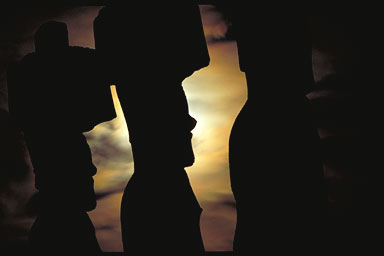
 |
|
Na'au:
The heart of wayfinding by
Sam Low
"Before we left I was panicked," Nainoa recalls. "I had the safety of the entire crew in my hands. There was intense media pressure. I had to appear confident, but inside I was very much afraid. And one of the things I feared most was the doldrums." (The doldrums are a band of ascending air near the equator marked by long periods of dead winds followed by buffeting, sky-obscuring rainstorms. This maddening zone of calms and squalls is a navigator's nightmare - thus the metaphor of being "down in the doldrums" to signify a state of mental depression.) Sure enough, Höküle'a became mired in the doldrums during the voyage, making little headway for seemingly days on end. Eventually, Nainoa radioed a friend aboard the escort boat. "I don't know where I am," he confessed. "I just keep going around in circles. I can't do anything." After hardly sleeping for days in order to maintain a continuous mental image of Höküle'a's position, he was nearing total exhaustion. Then, in the dead of night, a severe squall suddenly engulfed the canoe. "There was a hundred percent cloud cover," Nainoa remembers. "The wind was blowing hard, but it kept switching directions. The canoe was making good speed, but I wasn't sure which way we were headed, and that's the worst thing: You're going fast, but you don't know where." Racing along at ten knots, the steersman looked to Nainoa for guidance. Which way to go? He had no idea: "I was fighting to find a star in this blackness, but I couldn't see anything." In the dark void of that night, Nainoa's mind was a knot of fatigue. He couldn't think. He fought against despair. "I remember backing up against the rail, exhausted," he recalls. "And then, somehow, it was almost as if I gave up fighting. I just settled down, and this warmth came over me. All of a sudden I just knew where the moon was, even though I couldn't see it with my eyes." Nainoa's vision of the moon provided direction, but was he hallucinating? For a moment, his scientific mind wrestled with this deeper intuition, but then he relaxed and accepted it. "From the image of the moon came a strong sense of knowing where to go," he recalls. "I turned the canoe, got things lined up and felt very, very comfortable, even in the heavy rain and wind. And then, just for a moment, there was a hole in the clouds and the moon appeared - right where I thought it would be." Even today, Nainoa struggles with the words to define this experience: "From a scientific point of view, it's just unexplainable. It's something very deep that has nothing to do with intellect and everything to do with feelings. It's na'au, the knowledge of the heart. To tell you the truth, I don't really like to analyze it too much, but it's as if a door opens up to a new way of knowledge that you never even knew existed. For me, that was one of the most precious moments in all my time sailing. That's when I recognized the true meaning of being a navigator - that certain levels of traditional navigation are really realms of the spirit." |
Sam Low.com home | Biography | Library | Gallery | Screening Room | Forbears | Notebook | Contact Sam
Site, text, and images Copyright © 2002 Sam Low. All rights reserved. Any or all content may not be used without Sam's permission.